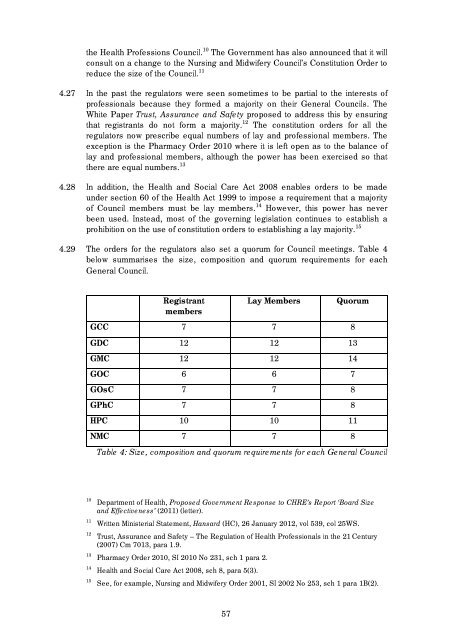Regulation of Health and Social Care Professionals Consultation
Regulation of Health and Social Care Professionals Consultation
Regulation of Health and Social Care Professionals Consultation
You also want an ePaper? Increase the reach of your titles
YUMPU automatically turns print PDFs into web optimized ePapers that Google loves.
the <strong>Health</strong> Pr<strong>of</strong>essions Council. 10 The Government has also announced that it will<br />
consult on a change to the Nursing <strong>and</strong> Midwifery Council’s Constitution Order to<br />
reduce the size <strong>of</strong> the Council. 11<br />
4.27 In the past the regulators were seen sometimes to be partial to the interests <strong>of</strong><br />
pr<strong>of</strong>essionals because they formed a majority on their General Councils. The<br />
White Paper Trust, Assurance <strong>and</strong> Safety proposed to address this by ensuring<br />
that registrants do not form a majority. 12 The constitution orders for all the<br />
regulators now prescribe equal numbers <strong>of</strong> lay <strong>and</strong> pr<strong>of</strong>essional members. The<br />
exception is the Pharmacy Order 2010 where it is left open as to the balance <strong>of</strong><br />
lay <strong>and</strong> pr<strong>of</strong>essional members, although the power has been exercised so that<br />
there are equal numbers. 13<br />
4.28 In addition, the <strong>Health</strong> <strong>and</strong> <strong>Social</strong> <strong>Care</strong> Act 2008 enables orders to be made<br />
under section 60 <strong>of</strong> the <strong>Health</strong> Act 1999 to impose a requirement that a majority<br />
<strong>of</strong> Council members must be lay members. 14 However, this power has never<br />
been used. Instead, most <strong>of</strong> the governing legislation continues to establish a<br />
prohibition on the use <strong>of</strong> constitution orders to establishing a lay majority. 15<br />
4.29 The orders for the regulators also set a quorum for Council meetings. Table 4<br />
below summarises the size, composition <strong>and</strong> quorum requirements for each<br />
General Council.<br />
Registrant<br />
members<br />
57<br />
Lay Members Quorum<br />
GCC 7 7 8<br />
GDC 12 12 13<br />
GMC 12 12 14<br />
GOC 6 6 7<br />
GOsC 7 7 8<br />
GPhC 7 7 8<br />
HPC 10 10 11<br />
NMC 7 7 8<br />
Table 4: Size, composition <strong>and</strong> quorum requirements for each General Council<br />
10<br />
Department <strong>of</strong> <strong>Health</strong>, Proposed Government Response to CHRE’s Report ‘Board Size<br />
<strong>and</strong> Effectiveness’ (2011) (letter).<br />
11 Written Ministerial Statement, Hansard (HC), 26 January 2012, vol 539, col 25WS.<br />
12<br />
Trust, Assurance <strong>and</strong> Safety – The <strong>Regulation</strong> <strong>of</strong> <strong>Health</strong> Pr<strong>of</strong>essionals in the 21 Century<br />
(2007) Cm 7013, para 1.9.<br />
13 Pharmacy Order 2010, SI 2010 No 231, sch 1 para 2.<br />
14 <strong>Health</strong> <strong>and</strong> <strong>Social</strong> <strong>Care</strong> Act 2008, sch 8, para 5(3).<br />
15 See, for example, Nursing <strong>and</strong> Midwifery Order 2001, SI 2002 No 253, sch 1 para 1B(2).
















